Related Research Articles

According to the International Civil Aviation Organization (ICAO), a runway is a "defined rectangular area on a land aerodrome prepared for the landing and takeoff of aircraft". Runways may be a human-made surface or a natural surface. Runways, taxiways and ramps, are sometimes referred to as "tarmac", though very few runways are built using tarmac. Takeoff and landing areas defined on the surface of water for seaplanes are generally referred to as waterways. Runway lengths are now commonly given in meters worldwide, except in North America where feet are commonly used.

Landing is the last part of a flight, where a flying animal, aircraft, or spacecraft returns to the ground. When the flying object returns to water, the process is called alighting, although it is commonly called "landing", "touchdown" or "splashdown" as well. A normal aircraft flight would include several parts of flight including taxi, takeoff, climb, cruise, descent and landing.


An electromagnetic catapult, also called EMALS after the specific US system, is a type of aircraft launching system. Currently, only the United States and China have successfully developed it, and it is installed on the Gerald R. Ford-class aircraft carriers and the Chinese aircraft carrier Fujian. The system launches carrier-based aircraft by means of a catapult employing a linear induction motor rather than the conventional steam piston.

Landing gear is the undercarriage of an aircraft or spacecraft that is used for takeoff or landing. For aircraft it is generally needed for both. It was also formerly called alighting gear by some manufacturers, such as the Glenn L. Martin Company. For aircraft, Stinton makes the terminology distinction undercarriage (British) = landing gear (US).
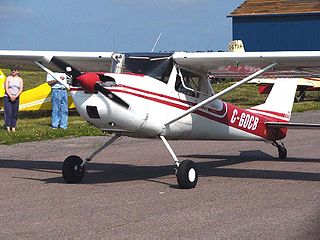
Conventional landing gear, or tailwheel-type landing gear, is an aircraft undercarriage consisting of two main wheels forward of the center of gravity and a small wheel or skid to support the tail. The term taildragger is also used, although John Brandon of Recreational Aircraft Australia argues it should apply only to those aircraft with a tailskid rather than a wheel.
Pegasus Airlines, sometimes stylized as Flypgs, is a Turkish low-cost carrier headquartered in the Kurtköy area of Pendik, Istanbul with bases at several Turkish airports.

Calicut International Airport, also known as Kozhikode International Airport or Karipur Airport, is an international airport serving the city of Kozhikode, Kerala, India. It is located at Karipur in the Malappuram district of the South Malabar region. It serves the Malabar region, consisting of Malappuram, Wayanad and Palakkad. It is situated 28 km (17 mi) away from Kozhikode and 25 km (16 mi) away from Malappuram. It serves two of the seven metropolitan areas in the state—Kozhikode metropolitan area and Malappuram metropolitan area. The airport opened on 13 April 1988. The airport serves as an operating base for Air India Express and operates Hajj Pilgrimage services to Medina and Jeddah from Kerala. It is tied with Hyderabad in terms of international traffic. It received international airport status on 2 February 2006. It is one of a few airports in the country with a tabletop runway.
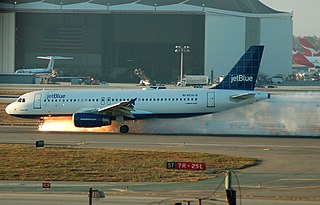
JetBlue Flight 292 was a scheduled flight from Bob Hope Airport in Burbank, California, to John F. Kennedy International Airport in New York City. On September 21, 2005, Captain Scott Burke executed an emergency landing in the Airbus A320-232 at Los Angeles International Airport after the nose gear jammed in an abnormal position. No one was injured.

Faisalabad International Airport is an international airport and standby Pakistan Air Force military base situated on Jhang Road, 10 kilometres (6.2 mi) southwest of the city centre of Faisalabad, in the Punjab province of Pakistan. The airport is home to two flying schools who use the airfield for regular training for new cadets and aviation enthusiasts.
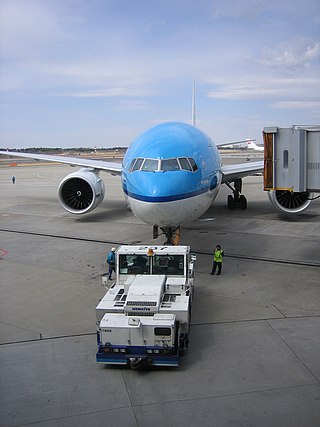
In aviation, pushback is an airport procedure during which an aircraft is pushed backwards away from its parking position, usually at an airport gate by external power. Pushbacks are carried out by special, low-profile vehicles called pushback tractors or tugs.

Floyd Bennett Memorial Airport is a county-owned, public-use airport in Warren County, New York, United States. It is located three nautical miles (6 km) northeast of the central business district of Glens Falls, in the town of Queensbury. This airport is included in the National Plan of Integrated Airport Systems for 2011–2015, which categorized it as a general aviation facility.
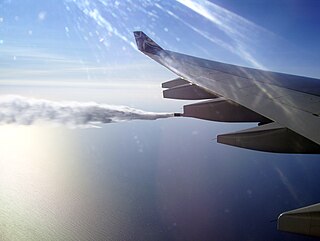
Fuel dumping is a procedure used by aircraft in certain emergency situations before a return to the airport shortly after takeoff, or before landing short of the intended destination to reduce the aircraft's weight.

Jackson County Airport, also known as Reynolds Field, is a county-owned, public-use airport located two nautical miles (3.7 km) west of the central business district of Jackson, in Jackson County, Michigan, United States. It is a class D airport with operating control tower. It is included in the Federal Aviation Administration (FAA) National Plan of Integrated Airport Systems for 2017–2021, in which it is categorized as a regional general aviation facility.

Mackinac Island Airport is a public use airport in Mackinac County, Michigan, United States. It is located one nautical mile (1.9 km) northwest of downtown Mackinac Island, Michigan in the center of Mackinac Island. The airport is owned by Mackinac Island State Park Commission. It is included in the Federal Aviation Administration (FAA) National Plan of Integrated Airport Systems for 2017–2021, in which it is categorized as a basic general aviation facility.
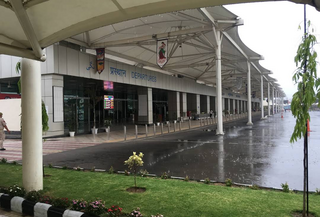
Jammu Airport, officially known as Jammu Civil Enclave, is a domestic airport serving Jammu, the winter capital of Jammu and Kashmir, India. It is located 6.1 km (3.8 mi) south of the city centre and 14 km (8.7 mi) from the India–Pakistan border.
Lake County Executive Airport, formerly Lost Nation Airport, is a public use airport in Lake County, Ohio, United States. Located approximately 3 miles (5 km) north-northeast of the central business district of the City of Willoughby, it was owned and operated by that city until October 8, 2014, when it was transferred to Lake County and the Lake County Port and Economic Development Authority. The airport's name was changed from Lost Nation Airport to Lake County Executive Airport, alternately "Lake County Executive Airport at Lost Nation Field," in March 2020.

Interflug Flight 102 ended in a crash involving an Ilyushin IL 62M on 17 June 1989. The aircraft, while attempting to take off from Berlin Schönefeld Airport, East Germany, crashed into obstacles on the ground at the end of its takeoff, costing 21 lives.
References
- ↑ Maaß, Stephan (1 November 2009). "In Zukunft sollen Flugzeuge ohne Räder landen". Die Welt.
- ↑ IATA Technology Roadmap (PDF) (4th ed.). IATA. 2013. p. 25.
- ↑ "Future by Airbus". airbus.com. Archived from the original on 2017-08-21.
- 1 2 Binnebesel, Jan. "Fliegen ohne Fahrwerk?" (PDF). mbptech.de.
- 1 2 3 4 Lütjens, K.H.; et al. (2012). "AIRPORT 2030 – Lösungen für den effizienten Lufttransport der Zukunft" (PDF). Deutscher Luft- und Raumfahrtkongress: 7 et seqq.
- ↑ Flugunfall-Untersuchungsstelle beim Luftfahrt-Bundesamt, ed. (November 1984). "Notlandung - mit ausgefahrenem Fahrwerk?" (PDF). Flugunfall-Information (V 34).
- 1 2 Rohacs, Daniel; Voskuijl, Mark; Rohacs, Jozsef; Schoustra, Rommert-Jan (2013). "Preliminary evaluation of the environmental impact related to aircraft take-off and landings supported with ground based (MAGLEV) power". Journal of Aerospace Operations. 2 (3–4): 161. doi:10.3233/AOP-140040.
- ↑ Hillmer, Angelika (3 December 2013). "Flugzeuge starten und landen ohne Fahrwerk". Hamburger Abendblatt.
- ↑ ""Future by Airbus" nutzt Bodenfahrwerkskonzept aus Hamburg". Hamburg Aviation. 1 October 2012. Archived from the original on 20 October 2014.
- ↑ "Hamburg auf der Luftfahrtmesse ILA". Hamburger Abendblatt. 21 May 2014.